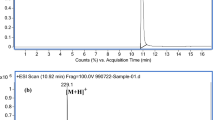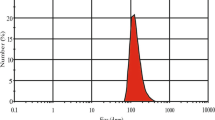Abstract
Purpose
Alzheimer’s disease is a neurodegenerative disorder, and most common form of dementia afflicting over 35 million people worldwide. Rivastigmine is a widely used therapeutic for ameliorating clinical manifestations of Alzheimer’s disease. However, current treatments require frequent dosing either orally or via transdermal patch that lead to compliance issues and administration errors risking serious adverse effects. Our objective was to develop a smart polymer based delivery system for controlled release of rivastigmine over an extended period following a single subcutaneous injection.
Methods
Rivastigmine release was optimized by tailoring critical factors including polymer concentration, polymer composition, drug concentration, solvent composition, and drug hydrophobicity (rivastigmine tartrate vs base). Optimized in vitro formulation was evaluated in vivo for safety and efficacy.
Results
Formulation prepared using PLGA (50:50) at 5% w/v in 95:5 benzyl benzoate: benzoic acid demonstrated desirable controlled drug release characteristics in vitro. The formulation demonstrated sustained release of rivastigmine tartrate for 7 days in vivo with promising biocompatibility and acetylcholinesterase inhibition efficacy for 14 days.
Conclusion
The results exemplify an easily injectable controlled release formulation of rivastigmine prepared using phase-sensitive smart polymer. The optimized formulation significantly increases the dosing interval, and can potentially improve patient compliance as well as quality of life of patients living with Alzheimer’s disease.









Similar content being viewed by others
References
National Institute of Aging. Alzheimer's Disease Fact Sheet.; Accessed: 2019 12/20. Available from: https://www.nia.nih.gov/health/alzheimers-disease-fact-sheet.
Weuve J, Hebert LE, Scherr PA, Evans DA. Deaths in the United States among persons with Alzheimer's disease (2010-2050). Alzheimers Dement. 2014;10(2):e40–6.
Alzheimer's association. Generation alzheimer's the defining disease of the baby boomers.; Accessed: 2019 12/20. Available from: https://act.alz.org/site/DocServer/ALZ_BoomersReport.pdf?docID=521.
National Cancer Institute. NCI Budget and Appropriations.; Accessed: 2019 12/20. Available from: https://www.cancer.gov/about-nci/budget.
Mather M, Harley CW. The locus Coeruleus: essential for maintaining cognitive function and the aging brain. Trends Cogn Sci. 2016;20(3):214–26.
Kumar A, Singh A. Ekavali. A review on Alzheimer's disease pathophysiology and its management: an update. Pharmacol Rep. 2015;67(2):195–203.
Nagy B, Brennan A, Brandtmuller A, Thomas SK, Sullivan SD, Akehurst R. Assessing the cost-effectiveness of the rivastigmine transdermal patch for Alzheimer's disease in the UK using MMSE- and ADL-based models. Int J Geriatr Psychiatry. 2011;26(5):483–94.
Kracmarova A, Drtinova L, Pohanka M. Possibility of Acetylcholinesterase overexpression in Alzheimer disease patients after therapy with Acetylcholinesterase inhibitors. Acta Med (Hradec Kralove). 2015;58(2):37–42.
Williams BR, Nazarians A, Gill MA. A review of rivastigmine: a reversible cholinesterase inhibitor. Clin Ther. 2003;25(6):1634–53.
Eskander MF, Nagykery NG, Leung EY, Khelghati B, Geula C. Rivastigmine is a potent inhibitor of acetyl- and butyrylcholinesterase in Alzheimer's plaques and tangles. Brain Res. 2005;1060(1–2):144–52.
Cotrell V, Wild K, Bader T. Medication management and adherence among cognitively impaired older adults. J Gerontol Soc Work. 2006;47(3–4):31–46.
Dhillon S. Spotlight on rivastigmine transdermal patch: in dementia of the Alzheimer's type. Drugs Aging. 2011;28(11):927–30.
Alva G, Grossberg GT, Schmitt FA, Meng X, Olin JT. Efficacy of rivastigmine transdermal patch on activities of daily living: item responder analyses. Int J Geriatr Psychiatry. 2011;26(4):356–63.
Uwano C, Suzuki M, Aikawa T, Ebihara T, Une K, Tomita N, et al. Rivastigmine dermal patch solves eating problems in an individual with advanced Alzheimer's disease. J Am Geriatr Soc. 2012;60(10):1979–80.
Adler G, Mueller B, Articus K. The transdermal formulation of rivastigmine improves caregiver burden and treatment adherence of patients with Alzheimer's disease under daily practice conditions. Int J Clin Pract. 2014;68(4):465–70.
Cortez Pinto L, Martinho Pimenta AJ, Figueira ML, Fernandes JM. More Patients Show Reduced Agitation/aggression with Rivastigmine Transdermal Monotherapy Than with Oral Monotherapies for Alzheimer’s Disease – Results From the Exept Study in Portugal. European Psychiatry 2015 28–31 March 2015;30:1445.
Dhillon S. Rivastigmine Transdermal Patch Drugs 2011;71(9).
Pratten MK, Lloyd JB, Hörpel G, Ringsdorf H. Micelle-forming block copolymers : pinocytosis by macrophages and interaction with model membranes. Die Makromol Chemie. 2003;186(4):725–33.
Chen S, Singh J. Controlled delivery of testosterone from smart polymer solution based systems: in vitro evaluation. Int J Pharm. 2005;295(1–2):183–90.
Rao BM, Srinivasu MK, Kumar KP, Bhradwaj N, Ravi R, Mohakhud PK, et al. A stability indicating LC method for Rivastigmine hydrogen tartrate. Journal of Pharmaceutical and Biomedical Analysis 2005 7 February 2005;37(1):57–63.
Nair AB, Jacob S. A simple practice guide for dose conversion between animals and human. J Basic Clin Pharm. 2016;7(2):27–31.
Wake MC, Gupta PK, Mikos AG. Fabrication of pliable biodegradable polymer foams to engineer soft tissues. Cell Transplant. 1996;5(4):465–73.
Bonacucina G, Cespi M, Mencarelli G, Giorgioni G, Filippo PG. Thermosensitive self-assembling block copolymers as drug delivery systems. Polymers. 2011;3(2):779–811.
Ellman GL. Tissue sulfhydryl groups. Arch Biochem Biophys. 1959;82(1):70–7.
Yamada K, Nabeshima T. Animal models of Alzheimer's disease and evaluation of anti-dementia drugs. Pharmacol Ther. 2000;88(2):93–113.
Chen S, Singh J. In vitro release of levonorgestrel from phase sensitive and thermosensitive smart polymer delivery systems. Pharm Dev Technol. 2005;10(2):319–25.
Chen S, Pederson D, Oak M, Singh J. In vivo absorption of steroidal hormones from smart polymer based delivery systems. J Pharm Sci. 2010;99(8):3381–8.
Tang Y, Singh J. Thermosensitive drug delivery system of salmon calcitonin: in vitro release, in vivo absorption, bioactivity and therapeutic efficacies. Pharm Res. 2010;27(2):272–84.
Tang Y, Singh J. Biodegradable and biocompatible thermosensitive polymer based injectable implant for controlled release of protein. Int J Pharm. 2009;365(1–2):34–43.
Chen S, Pieper R, Webster DC, Singh J. Triblock copolymers: synthesis, characterization, and delivery of a model protein. Int J Pharm. 2005;288(2):207–18.
Al-Tahami K, Oak M, Mandke R, Singh J. Basal level insulin delivery: in vitro release, stability, biocompatibility, and in vivo absorption from thermosensitive triblock copolymers. J Pharm Sci. 2011;100(11):4790–803.
Oak M, Singh J. Controlled delivery of basal level of insulin from chitosan-zinc-insulin-complex-loaded thermosensitive copolymer. J Pharm Sci. 2012;101(3):1079–96.
Oak M, Singh J. Chitosan-zinc-insulin complex incorporated thermosensitive polymer for controlled delivery of basal insulin in vivo. J Control Release. 2012;163(2):145–53.
Oak M, Mandke R, Lakkadwala S, Lipp L, Singh J. Effect of molar mass and water solubility of incorporated molecules on the degradation profile of the triblock copolymer delivery system. Polymers. 2015;7(8):1510–21.
Sharma D, Arora S, Singh J. Smart thermosensitive copolymer incorporating chitosan–zinc–insulin electrostatic complexes for controlled delivery of insulin: effect of chitosan chain length. Int J Polym Mater Polym Biomater. 2019.
Shaikh J. Benzyl Benzoate. In: Wexler P, editor. Encyclopedia of Toxicology. 2nd ed.: Elsevier; 2005. p. 264–265.
Schwendeman SP, Shah RB, Bailey BA, Schwendeman AS. Injectable controlled release depots for large molecules. J Control Release. 2014;190:240–53.
ACKNOWLEGEMENTS AND DISCLOSURES
This research was supported by the National Institutes of Health (NIH) grant# R15GM114701. The authors declare no conflict of interest regarding the publication of this article.
Author information
Authors and Affiliations
Corresponding author
Additional information
Publisher’s Note
Springer Nature remains neutral with regard to jurisdictional claims in published maps and institutional affiliations.
Rights and permissions
About this article
Cite this article
Lipp, L., Sharma, D., Banerjee, A. et al. In Vitro and in Vivo Optimization of Phase Sensitive Smart Polymer for Controlled Delivery of Rivastigmine for Treatment of Alzheimer’s Disease. Pharm Res 37, 34 (2020). https://doi.org/10.1007/s11095-020-2757-6
Received:
Accepted:
Published:
DOI: https://doi.org/10.1007/s11095-020-2757-6




